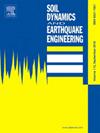Dynamic response of hybrid foundation for jack-up platform on sandy seabed under horizontal cyclic loading
IF 4.2
2区 工程技术
Q1 ENGINEERING, GEOLOGICAL
引用次数: 0
Abstract
To address the challenges of extraction difficulties and penetration risks associated with traditional spudcan jack-up platforms, a new jack-up platform featuring a pile-leg mat foundation is proposed. The horizontal bearing capacity of hybrid foundations under the influence of dynamic loads is a critical factor that requires close attention. This research numerically examined the dynamic response of a hybrid foundation to horizontal cyclic loading on a sandy seabed. A user-defined subroutine was employed to incorporate the Cyclic Mobility (CM) model within Abaqus, facilitating the analysis of sand response under different densities. The horizontal cyclic bearing capacities of the foundation were investigated considering the effects of different loading conditions, sand density, and pile-leg penetration depth. Simulation results indicate that the cyclic loading amplitude, frequency, and load mode significantly influence the generation of soil excess pore water pressure (EPWP), subsequently affecting foundation displacement and unloading stiffness. Under cyclic loading, the loose sandy seabed shows the most pronounced fluctuations in EPWP and effective stress, leading to surface soil liquefaction. While surface soil in medium-dense and dense sand conditions remains non-liquefied, their effective stress still varies significantly. Increasing the pile-leg penetration depth enhances the foundation's horizontal bearing capacity while affecting its vertical bearing capacity slightly.
求助全文
约1分钟内获得全文
求助全文
来源期刊

Soil Dynamics and Earthquake Engineering
工程技术-地球科学综合
CiteScore
7.50
自引率
15.00%
发文量
446
审稿时长
8 months
期刊介绍:
The journal aims to encourage and enhance the role of mechanics and other disciplines as they relate to earthquake engineering by providing opportunities for the publication of the work of applied mathematicians, engineers and other applied scientists involved in solving problems closely related to the field of earthquake engineering and geotechnical earthquake engineering.
Emphasis is placed on new concepts and techniques, but case histories will also be published if they enhance the presentation and understanding of new technical concepts.
 求助内容:
求助内容: 应助结果提醒方式:
应助结果提醒方式:


